Financial Project Report: Investment Analysis Using Capital Budgeting
VerifiedAdded on 2023/06/12
|9
|1578
|348
Report
AI Summary
This report evaluates the financial concepts of Freemantle Manufacturing, calculating the Weighted Average Cost of Capital (WACC) to determine the discount rate. It then assesses a long-term investment project using Net Present Value (NPV), Internal Rate of Return (IRR), and payback period m...
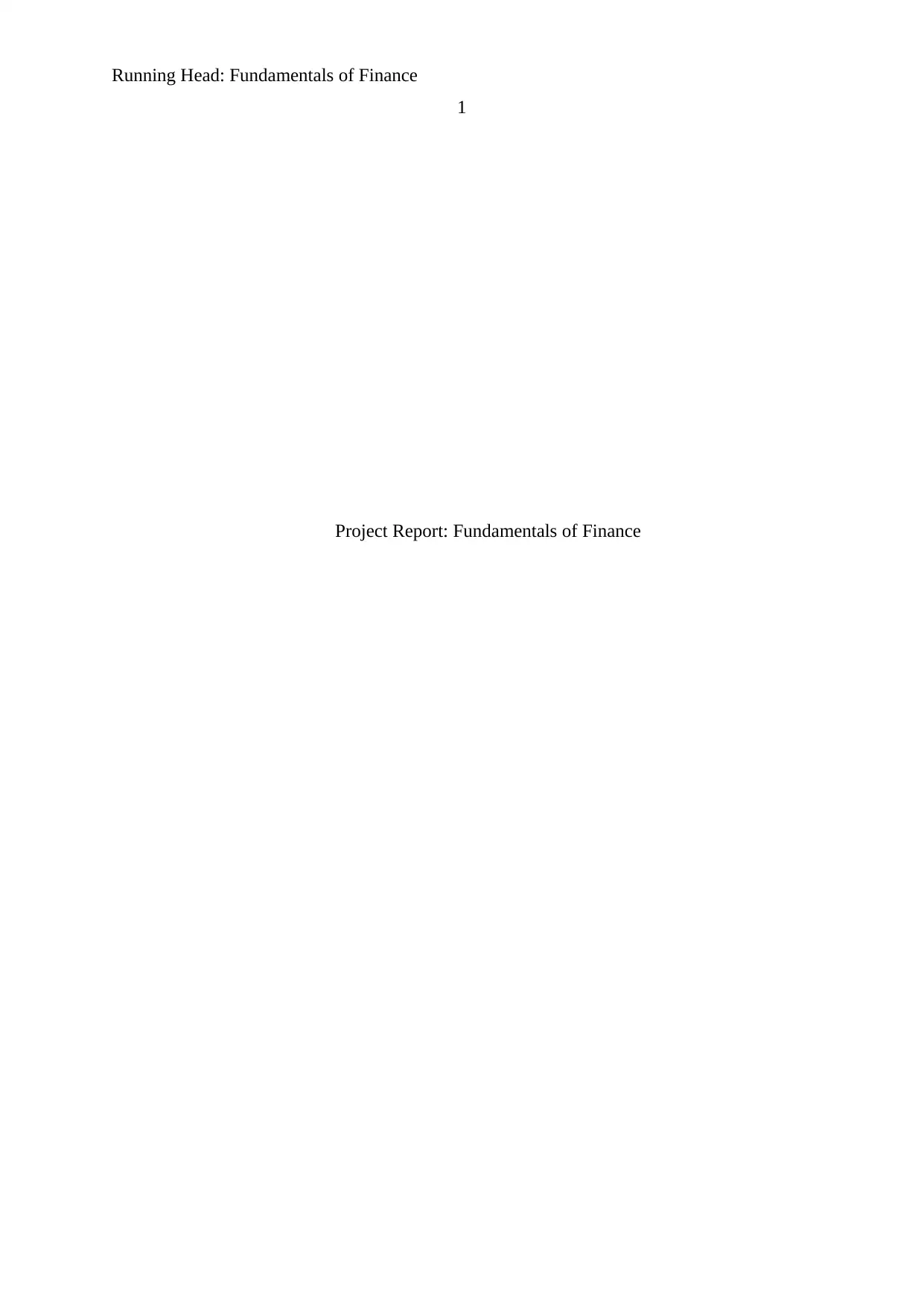
Running Head: Fundamentals of Finance
1
Project Report: Fundamentals of Finance
1
Project Report: Fundamentals of Finance
Paraphrase This Document
Need a fresh take? Get an instant paraphrase of this document with our AI Paraphraser
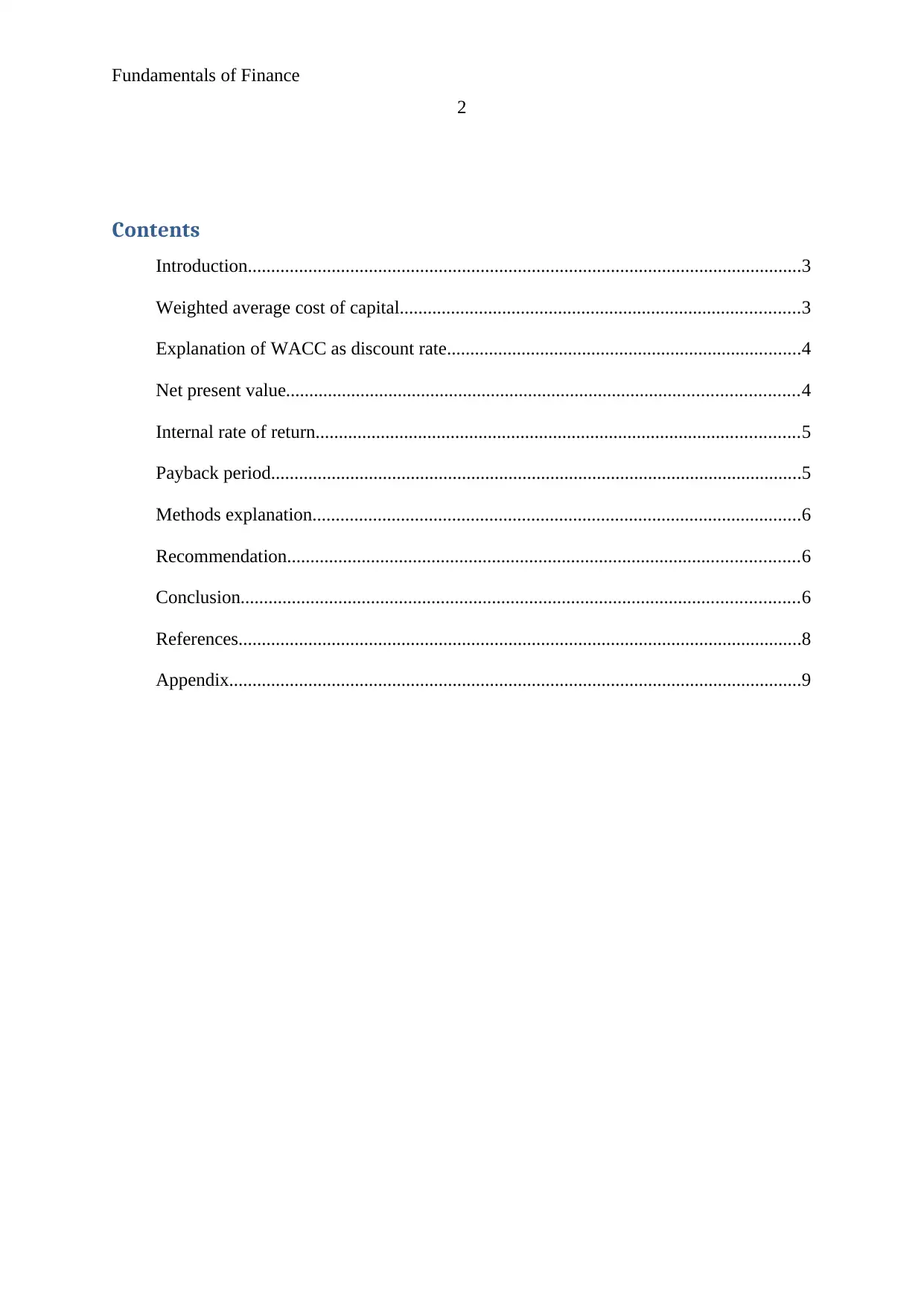
Fundamentals of Finance
2
Contents
Introduction.......................................................................................................................3
Weighted average cost of capital......................................................................................3
Explanation of WACC as discount rate............................................................................4
Net present value..............................................................................................................4
Internal rate of return........................................................................................................5
Payback period..................................................................................................................5
Methods explanation.........................................................................................................6
Recommendation..............................................................................................................6
Conclusion........................................................................................................................6
References.........................................................................................................................8
Appendix...........................................................................................................................9
2
Contents
Introduction.......................................................................................................................3
Weighted average cost of capital......................................................................................3
Explanation of WACC as discount rate............................................................................4
Net present value..............................................................................................................4
Internal rate of return........................................................................................................5
Payback period..................................................................................................................5
Methods explanation.........................................................................................................6
Recommendation..............................................................................................................6
Conclusion........................................................................................................................6
References.........................................................................................................................8
Appendix...........................................................................................................................9

Fundamentals of Finance
3
Introduction:
This report has been prepared to evaluate the financial concepts and non financial
concepts of an organization. In the report, WACC of the Freemantle Manufacturing company
limited has been calculated firstly to calculate the discount rate of the company. And on the
basis of discount rate, net present value, internal rate of return and payback period of the
company has been calculated. This report evaluates that which method is the best option to
evaluate the investment proposal.
Weighted average cost of capital:
Weighted average cost of capital (WACC) measures the total cost of capital of the
company which has been generated while enhancing the funds for the long term projects and
the investment proposal of the company (Brijlal, 2008). For calculating the WACC, cost of
bond, cost of equity and cost of preference share has been calculated which are as follows:
Calculation of cost of bond
Bond amount 17,00,000
interest rate 5.50%
Yield to maturity 1.87%
Net interest amount 4.87%
Tax rate 30.0%
Kd 3.85%
Calculation of cost of equity
(CAPM)
RF 2.25%
RM 7.10%
Beta 1.300
Required rate of return 8.56%
Calculation of cost of preference
share
Preference share 12,00,000
Dividend 1.39
Market price 11.56
Cost of preference share 12.02%
(Besley and Brigham, 2007)
3
Introduction:
This report has been prepared to evaluate the financial concepts and non financial
concepts of an organization. In the report, WACC of the Freemantle Manufacturing company
limited has been calculated firstly to calculate the discount rate of the company. And on the
basis of discount rate, net present value, internal rate of return and payback period of the
company has been calculated. This report evaluates that which method is the best option to
evaluate the investment proposal.
Weighted average cost of capital:
Weighted average cost of capital (WACC) measures the total cost of capital of the
company which has been generated while enhancing the funds for the long term projects and
the investment proposal of the company (Brijlal, 2008). For calculating the WACC, cost of
bond, cost of equity and cost of preference share has been calculated which are as follows:
Calculation of cost of bond
Bond amount 17,00,000
interest rate 5.50%
Yield to maturity 1.87%
Net interest amount 4.87%
Tax rate 30.0%
Kd 3.85%
Calculation of cost of equity
(CAPM)
RF 2.25%
RM 7.10%
Beta 1.300
Required rate of return 8.56%
Calculation of cost of preference
share
Preference share 12,00,000
Dividend 1.39
Market price 11.56
Cost of preference share 12.02%
(Besley and Brigham, 2007)
⊘ This is a preview!⊘
Do you want full access?
Subscribe today to unlock all pages.

Trusted by 1+ million students worldwide
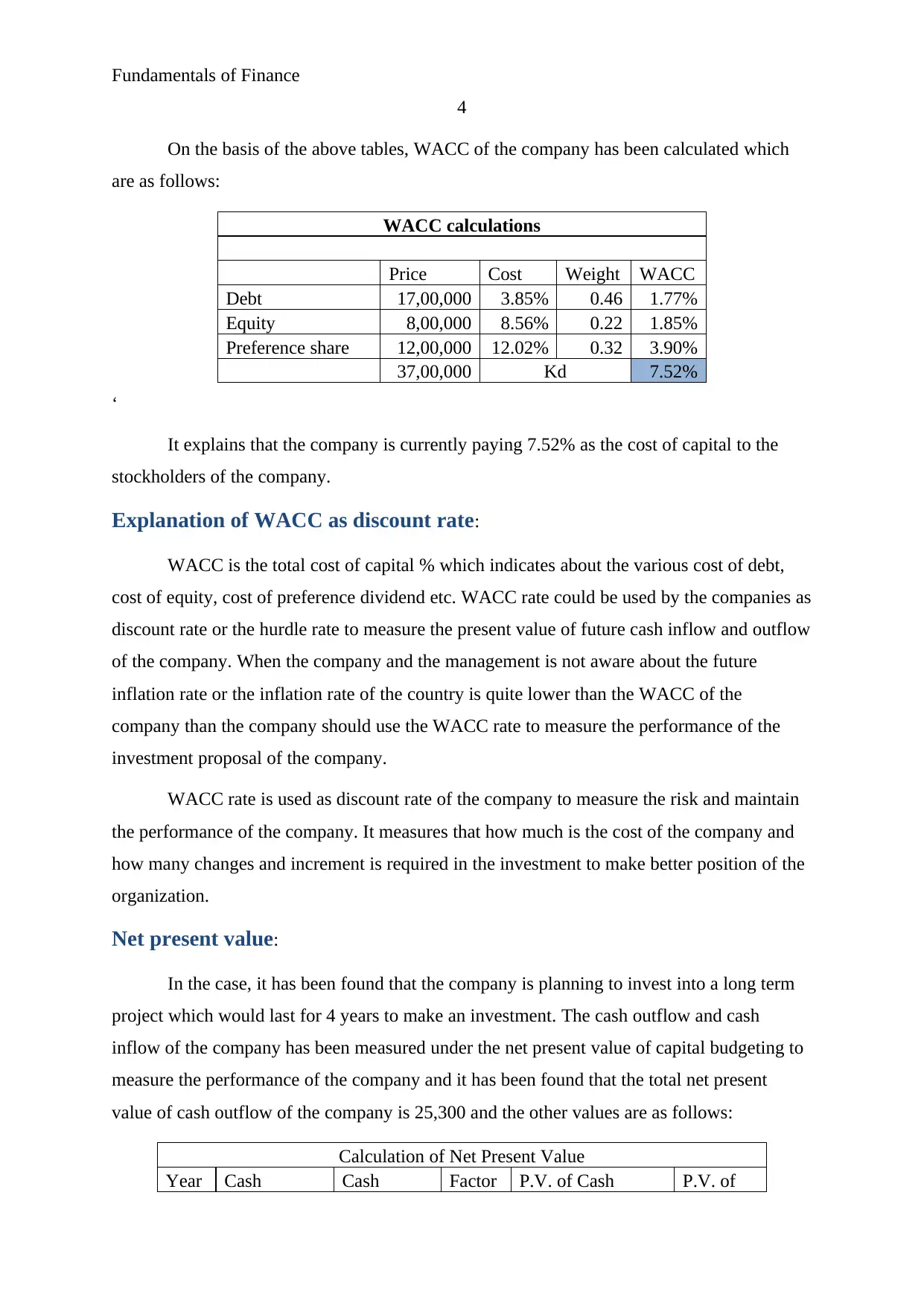
Fundamentals of Finance
4
On the basis of the above tables, WACC of the company has been calculated which
are as follows:
WACC calculations
Price Cost Weight WACC
Debt 17,00,000 3.85% 0.46 1.77%
Equity 8,00,000 8.56% 0.22 1.85%
Preference share 12,00,000 12.02% 0.32 3.90%
37,00,000 Kd 7.52%
‘
It explains that the company is currently paying 7.52% as the cost of capital to the
stockholders of the company.
Explanation of WACC as discount rate:
WACC is the total cost of capital % which indicates about the various cost of debt,
cost of equity, cost of preference dividend etc. WACC rate could be used by the companies as
discount rate or the hurdle rate to measure the present value of future cash inflow and outflow
of the company. When the company and the management is not aware about the future
inflation rate or the inflation rate of the country is quite lower than the WACC of the
company than the company should use the WACC rate to measure the performance of the
investment proposal of the company.
WACC rate is used as discount rate of the company to measure the risk and maintain
the performance of the company. It measures that how much is the cost of the company and
how many changes and increment is required in the investment to make better position of the
organization.
Net present value:
In the case, it has been found that the company is planning to invest into a long term
project which would last for 4 years to make an investment. The cash outflow and cash
inflow of the company has been measured under the net present value of capital budgeting to
measure the performance of the company and it has been found that the total net present
value of cash outflow of the company is 25,300 and the other values are as follows:
Calculation of Net Present Value
Year Cash Cash Factor P.V. of Cash P.V. of
4
On the basis of the above tables, WACC of the company has been calculated which
are as follows:
WACC calculations
Price Cost Weight WACC
Debt 17,00,000 3.85% 0.46 1.77%
Equity 8,00,000 8.56% 0.22 1.85%
Preference share 12,00,000 12.02% 0.32 3.90%
37,00,000 Kd 7.52%
‘
It explains that the company is currently paying 7.52% as the cost of capital to the
stockholders of the company.
Explanation of WACC as discount rate:
WACC is the total cost of capital % which indicates about the various cost of debt,
cost of equity, cost of preference dividend etc. WACC rate could be used by the companies as
discount rate or the hurdle rate to measure the present value of future cash inflow and outflow
of the company. When the company and the management is not aware about the future
inflation rate or the inflation rate of the country is quite lower than the WACC of the
company than the company should use the WACC rate to measure the performance of the
investment proposal of the company.
WACC rate is used as discount rate of the company to measure the risk and maintain
the performance of the company. It measures that how much is the cost of the company and
how many changes and increment is required in the investment to make better position of the
organization.
Net present value:
In the case, it has been found that the company is planning to invest into a long term
project which would last for 4 years to make an investment. The cash outflow and cash
inflow of the company has been measured under the net present value of capital budgeting to
measure the performance of the company and it has been found that the total net present
value of cash outflow of the company is 25,300 and the other values are as follows:
Calculation of Net Present Value
Year Cash Cash Factor P.V. of Cash P.V. of
Paraphrase This Document
Need a fresh take? Get an instant paraphrase of this document with our AI Paraphraser
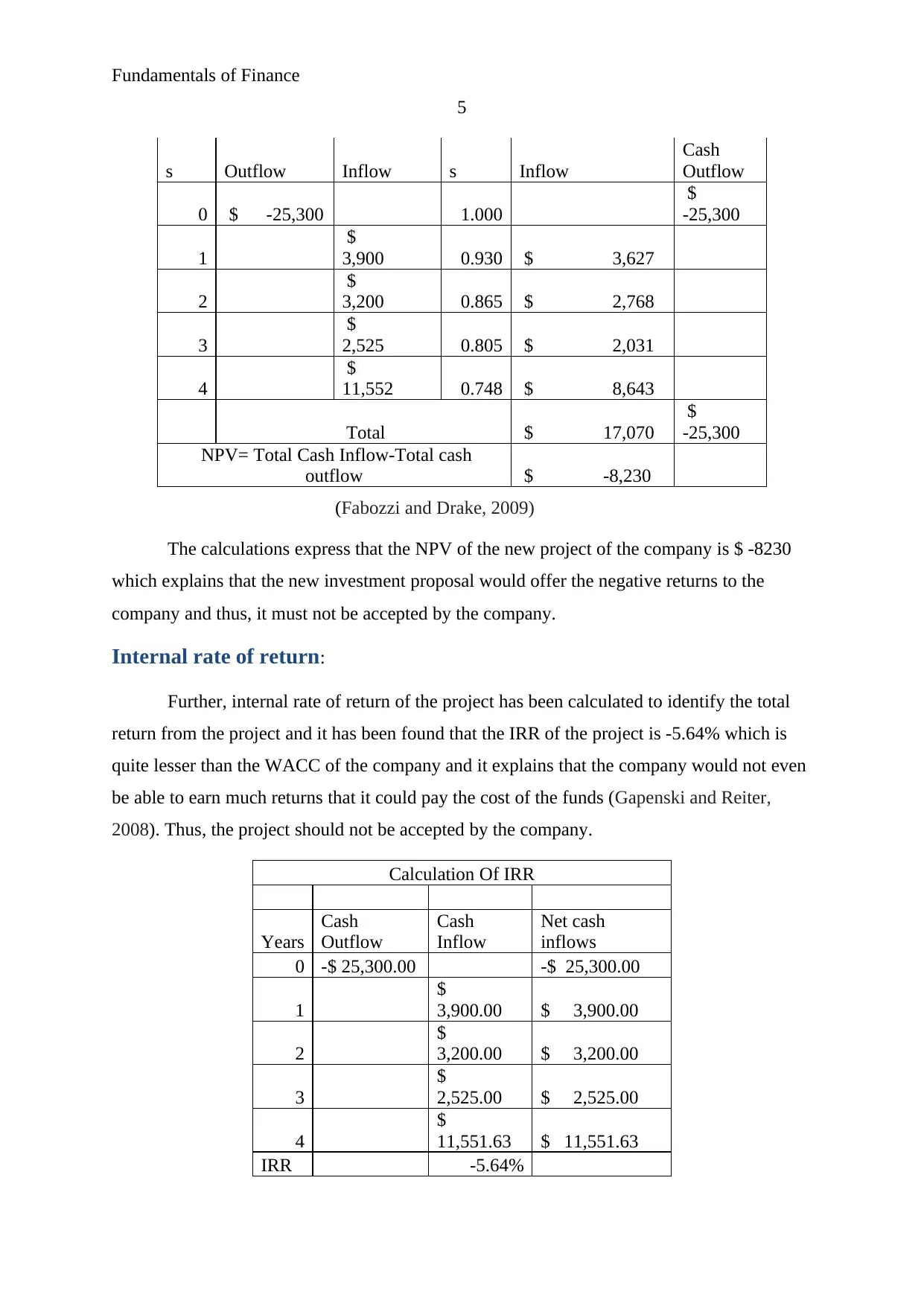
Fundamentals of Finance
5
s Outflow Inflow s Inflow
Cash
Outflow
0 $ -25,300 1.000
$
-25,300
1
$
3,900 0.930 $ 3,627
2
$
3,200 0.865 $ 2,768
3
$
2,525 0.805 $ 2,031
4
$
11,552 0.748 $ 8,643
Total $ 17,070
$
-25,300
NPV= Total Cash Inflow-Total cash
outflow $ -8,230
(Fabozzi and Drake, 2009)
The calculations express that the NPV of the new project of the company is $ -8230
which explains that the new investment proposal would offer the negative returns to the
company and thus, it must not be accepted by the company.
Internal rate of return:
Further, internal rate of return of the project has been calculated to identify the total
return from the project and it has been found that the IRR of the project is -5.64% which is
quite lesser than the WACC of the company and it explains that the company would not even
be able to earn much returns that it could pay the cost of the funds (Gapenski and Reiter,
2008). Thus, the project should not be accepted by the company.
Calculation Of IRR
Years
Cash
Outflow
Cash
Inflow
Net cash
inflows
0 -$ 25,300.00 -$ 25,300.00
1
$
3,900.00 $ 3,900.00
2
$
3,200.00 $ 3,200.00
3
$
2,525.00 $ 2,525.00
4
$
11,551.63 $ 11,551.63
IRR -5.64%
5
s Outflow Inflow s Inflow
Cash
Outflow
0 $ -25,300 1.000
$
-25,300
1
$
3,900 0.930 $ 3,627
2
$
3,200 0.865 $ 2,768
3
$
2,525 0.805 $ 2,031
4
$
11,552 0.748 $ 8,643
Total $ 17,070
$
-25,300
NPV= Total Cash Inflow-Total cash
outflow $ -8,230
(Fabozzi and Drake, 2009)
The calculations express that the NPV of the new project of the company is $ -8230
which explains that the new investment proposal would offer the negative returns to the
company and thus, it must not be accepted by the company.
Internal rate of return:
Further, internal rate of return of the project has been calculated to identify the total
return from the project and it has been found that the IRR of the project is -5.64% which is
quite lesser than the WACC of the company and it explains that the company would not even
be able to earn much returns that it could pay the cost of the funds (Gapenski and Reiter,
2008). Thus, the project should not be accepted by the company.
Calculation Of IRR
Years
Cash
Outflow
Cash
Inflow
Net cash
inflows
0 -$ 25,300.00 -$ 25,300.00
1
$
3,900.00 $ 3,900.00
2
$
3,200.00 $ 3,200.00
3
$
2,525.00 $ 2,525.00
4
$
11,551.63 $ 11,551.63
IRR -5.64%
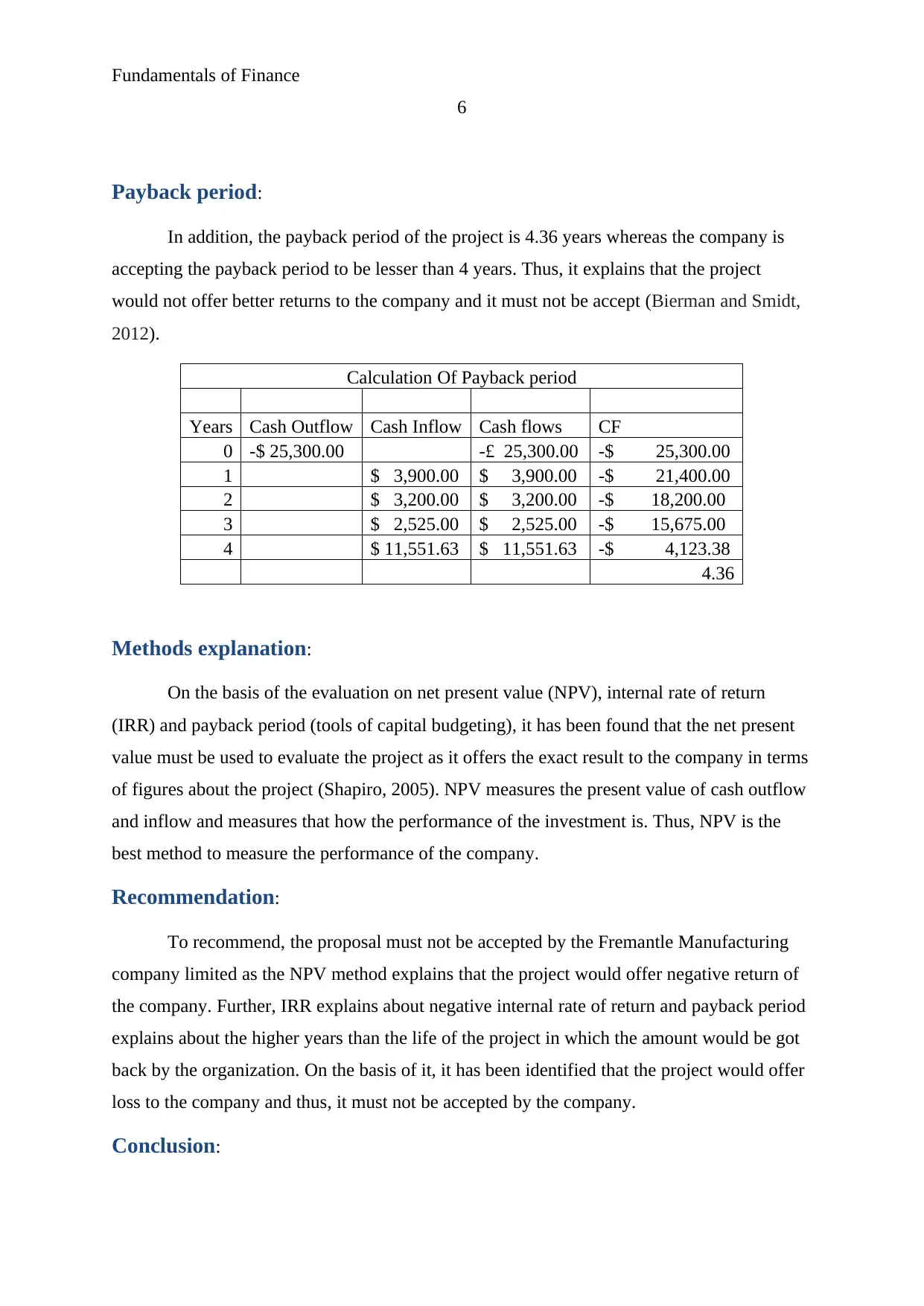
Fundamentals of Finance
6
Payback period:
In addition, the payback period of the project is 4.36 years whereas the company is
accepting the payback period to be lesser than 4 years. Thus, it explains that the project
would not offer better returns to the company and it must not be accept (Bierman and Smidt,
2012).
Calculation Of Payback period
Years Cash Outflow Cash Inflow Cash flows CF
0 -$ 25,300.00 -£ 25,300.00 -$ 25,300.00
1 $ 3,900.00 $ 3,900.00 -$ 21,400.00
2 $ 3,200.00 $ 3,200.00 -$ 18,200.00
3 $ 2,525.00 $ 2,525.00 -$ 15,675.00
4 $ 11,551.63 $ 11,551.63 -$ 4,123.38
4.36
Methods explanation:
On the basis of the evaluation on net present value (NPV), internal rate of return
(IRR) and payback period (tools of capital budgeting), it has been found that the net present
value must be used to evaluate the project as it offers the exact result to the company in terms
of figures about the project (Shapiro, 2005). NPV measures the present value of cash outflow
and inflow and measures that how the performance of the investment is. Thus, NPV is the
best method to measure the performance of the company.
Recommendation:
To recommend, the proposal must not be accepted by the Fremantle Manufacturing
company limited as the NPV method explains that the project would offer negative return of
the company. Further, IRR explains about negative internal rate of return and payback period
explains about the higher years than the life of the project in which the amount would be got
back by the organization. On the basis of it, it has been identified that the project would offer
loss to the company and thus, it must not be accepted by the company.
Conclusion:
6
Payback period:
In addition, the payback period of the project is 4.36 years whereas the company is
accepting the payback period to be lesser than 4 years. Thus, it explains that the project
would not offer better returns to the company and it must not be accept (Bierman and Smidt,
2012).
Calculation Of Payback period
Years Cash Outflow Cash Inflow Cash flows CF
0 -$ 25,300.00 -£ 25,300.00 -$ 25,300.00
1 $ 3,900.00 $ 3,900.00 -$ 21,400.00
2 $ 3,200.00 $ 3,200.00 -$ 18,200.00
3 $ 2,525.00 $ 2,525.00 -$ 15,675.00
4 $ 11,551.63 $ 11,551.63 -$ 4,123.38
4.36
Methods explanation:
On the basis of the evaluation on net present value (NPV), internal rate of return
(IRR) and payback period (tools of capital budgeting), it has been found that the net present
value must be used to evaluate the project as it offers the exact result to the company in terms
of figures about the project (Shapiro, 2005). NPV measures the present value of cash outflow
and inflow and measures that how the performance of the investment is. Thus, NPV is the
best method to measure the performance of the company.
Recommendation:
To recommend, the proposal must not be accepted by the Fremantle Manufacturing
company limited as the NPV method explains that the project would offer negative return of
the company. Further, IRR explains about negative internal rate of return and payback period
explains about the higher years than the life of the project in which the amount would be got
back by the organization. On the basis of it, it has been identified that the project would offer
loss to the company and thus, it must not be accepted by the company.
Conclusion:
⊘ This is a preview!⊘
Do you want full access?
Subscribe today to unlock all pages.

Trusted by 1+ million students worldwide
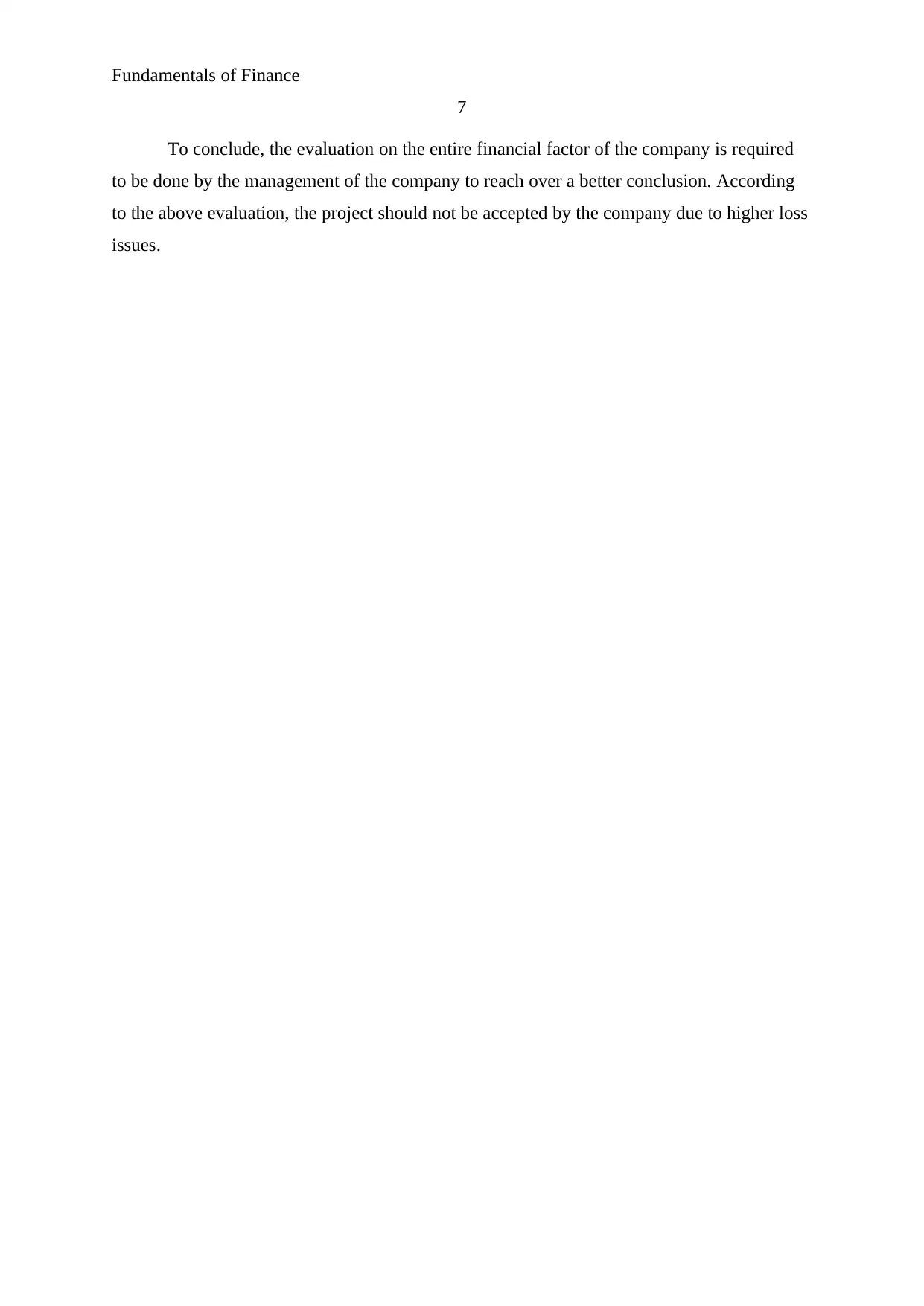
Fundamentals of Finance
7
To conclude, the evaluation on the entire financial factor of the company is required
to be done by the management of the company to reach over a better conclusion. According
to the above evaluation, the project should not be accepted by the company due to higher loss
issues.
7
To conclude, the evaluation on the entire financial factor of the company is required
to be done by the management of the company to reach over a better conclusion. According
to the above evaluation, the project should not be accepted by the company due to higher loss
issues.
Paraphrase This Document
Need a fresh take? Get an instant paraphrase of this document with our AI Paraphraser
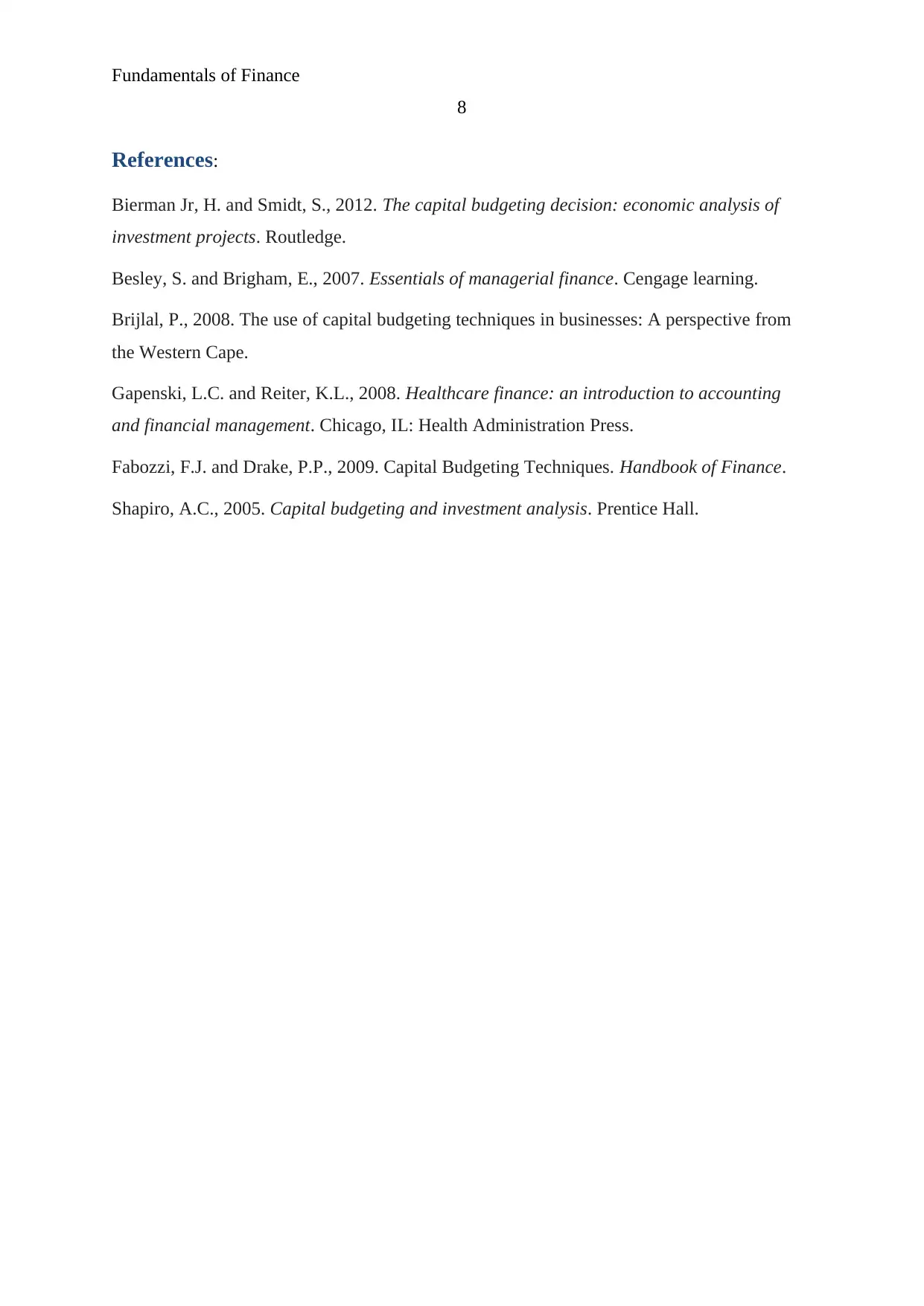
Fundamentals of Finance
8
References:
Bierman Jr, H. and Smidt, S., 2012. The capital budgeting decision: economic analysis of
investment projects. Routledge.
Besley, S. and Brigham, E., 2007. Essentials of managerial finance. Cengage learning.
Brijlal, P., 2008. The use of capital budgeting techniques in businesses: A perspective from
the Western Cape.
Gapenski, L.C. and Reiter, K.L., 2008. Healthcare finance: an introduction to accounting
and financial management. Chicago, IL: Health Administration Press.
Fabozzi, F.J. and Drake, P.P., 2009. Capital Budgeting Techniques. Handbook of Finance.
Shapiro, A.C., 2005. Capital budgeting and investment analysis. Prentice Hall.
8
References:
Bierman Jr, H. and Smidt, S., 2012. The capital budgeting decision: economic analysis of
investment projects. Routledge.
Besley, S. and Brigham, E., 2007. Essentials of managerial finance. Cengage learning.
Brijlal, P., 2008. The use of capital budgeting techniques in businesses: A perspective from
the Western Cape.
Gapenski, L.C. and Reiter, K.L., 2008. Healthcare finance: an introduction to accounting
and financial management. Chicago, IL: Health Administration Press.
Fabozzi, F.J. and Drake, P.P., 2009. Capital Budgeting Techniques. Handbook of Finance.
Shapiro, A.C., 2005. Capital budgeting and investment analysis. Prentice Hall.
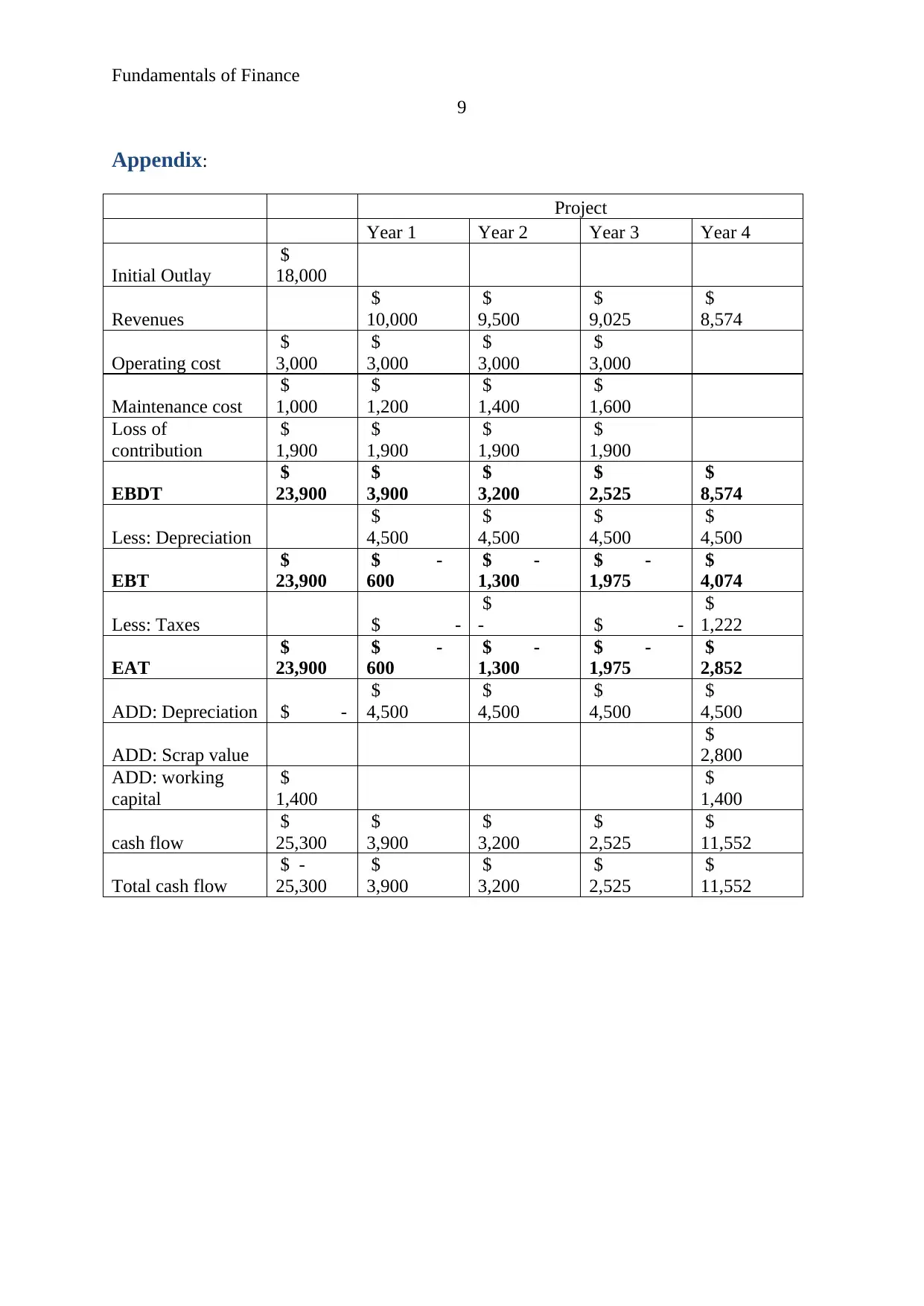
Fundamentals of Finance
9
Appendix:
Project
Year 1 Year 2 Year 3 Year 4
Initial Outlay
$
18,000
Revenues
$
10,000
$
9,500
$
9,025
$
8,574
Operating cost
$
3,000
$
3,000
$
3,000
$
3,000
Maintenance cost
$
1,000
$
1,200
$
1,400
$
1,600
Loss of
contribution
$
1,900
$
1,900
$
1,900
$
1,900
EBDT
$
23,900
$
3,900
$
3,200
$
2,525
$
8,574
Less: Depreciation
$
4,500
$
4,500
$
4,500
$
4,500
EBT
$
23,900
$ -
600
$ -
1,300
$ -
1,975
$
4,074
Less: Taxes $ -
$
- $ -
$
1,222
EAT
$
23,900
$ -
600
$ -
1,300
$ -
1,975
$
2,852
ADD: Depreciation $ -
$
4,500
$
4,500
$
4,500
$
4,500
ADD: Scrap value
$
2,800
ADD: working
capital
$
1,400
$
1,400
cash flow
$
25,300
$
3,900
$
3,200
$
2,525
$
11,552
Total cash flow
$ -
25,300
$
3,900
$
3,200
$
2,525
$
11,552
9
Appendix:
Project
Year 1 Year 2 Year 3 Year 4
Initial Outlay
$
18,000
Revenues
$
10,000
$
9,500
$
9,025
$
8,574
Operating cost
$
3,000
$
3,000
$
3,000
$
3,000
Maintenance cost
$
1,000
$
1,200
$
1,400
$
1,600
Loss of
contribution
$
1,900
$
1,900
$
1,900
$
1,900
EBDT
$
23,900
$
3,900
$
3,200
$
2,525
$
8,574
Less: Depreciation
$
4,500
$
4,500
$
4,500
$
4,500
EBT
$
23,900
$ -
600
$ -
1,300
$ -
1,975
$
4,074
Less: Taxes $ -
$
- $ -
$
1,222
EAT
$
23,900
$ -
600
$ -
1,300
$ -
1,975
$
2,852
ADD: Depreciation $ -
$
4,500
$
4,500
$
4,500
$
4,500
ADD: Scrap value
$
2,800
ADD: working
capital
$
1,400
$
1,400
cash flow
$
25,300
$
3,900
$
3,200
$
2,525
$
11,552
Total cash flow
$ -
25,300
$
3,900
$
3,200
$
2,525
$
11,552
⊘ This is a preview!⊘
Do you want full access?
Subscribe today to unlock all pages.

Trusted by 1+ million students worldwide
1 out of 9
Related Documents
Your All-in-One AI-Powered Toolkit for Academic Success.
+13062052269
info@desklib.com
Available 24*7 on WhatsApp / Email
![[object Object]](/_next/static/media/star-bottom.7253800d.svg)
Unlock your academic potential
© 2024 | Zucol Services PVT LTD | All rights reserved.





